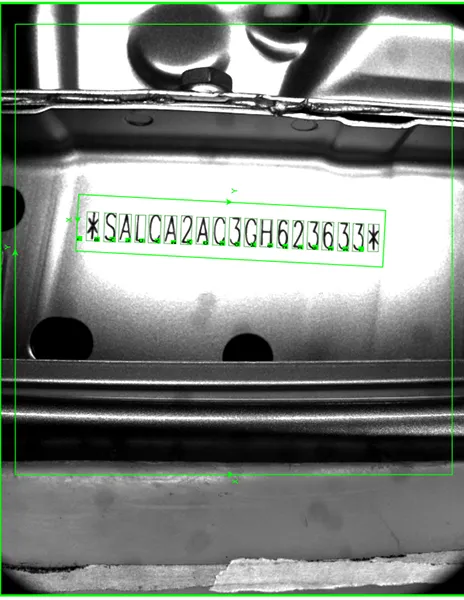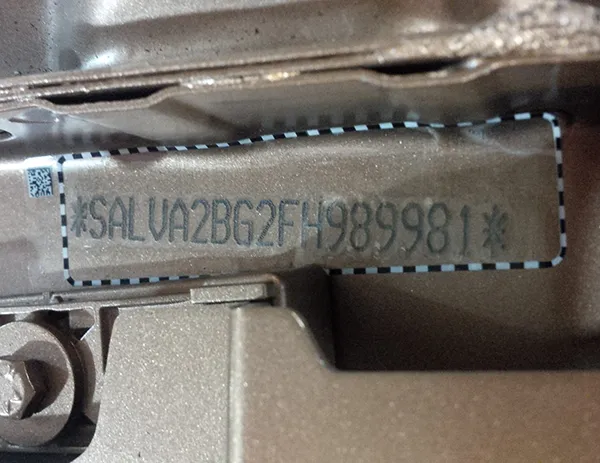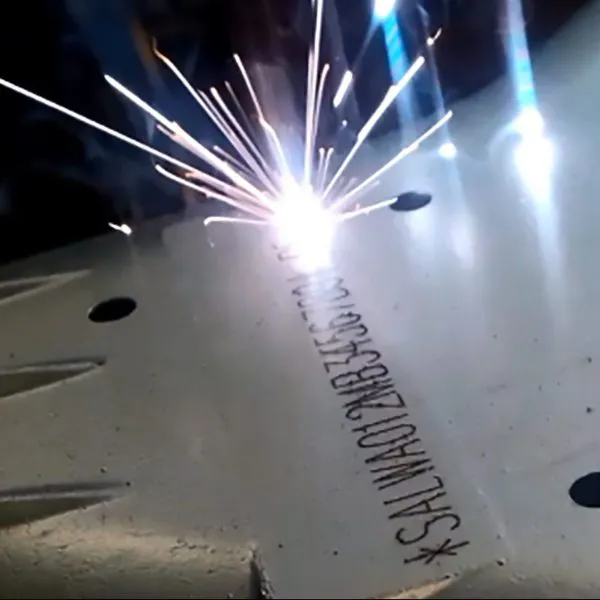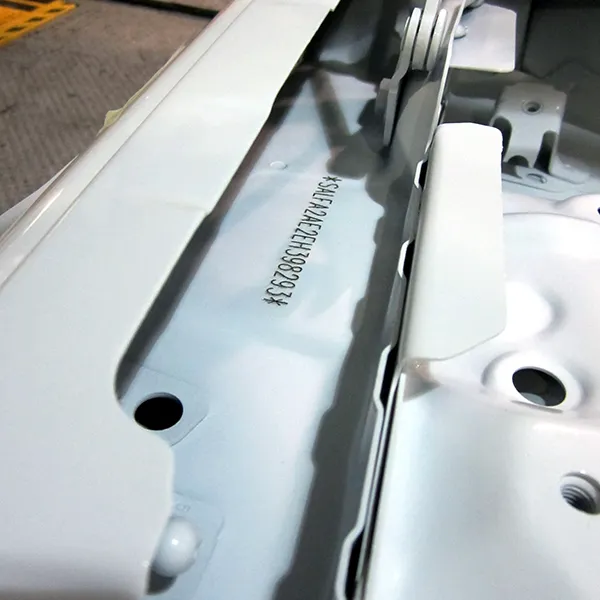Jaguar Land Rover VIN Marking
Automated laser VIN marking helps improve speed, quality and flexibility at Jaguar Land Rover.
The Vehicle Identification Number (VIN) is a car’s unique fingerprint. Usually applied to the vehicle body after painting, but before other components have been installed on the assembly line, the VIN serves many purposes throughout the life of a car. It helps mechanics identify the right parts and procedures to use in service and repair activities, for example. And it allows insurers and law enforcement agencies to identify vehicles that have been stolen, or illicitly put back on the road after a serious accident.
Applying the VIN has always presented challenges to manufacturers, however. The mark, which today is an internationally agreed standard combination of 17 numbers and letters, must be accurate and clear enough to remain legible for the life of the vehicle. It must also be applied rapidly, on production lines that may have a cycle time of just a few seconds.
Those demands have encouraged carmakers to find automated approaches to vehicle marking. The manual marking approach used in the 20th century is simply too slow and too error-prone to suit modern manufacturing environments.
VIN Marking Summary
Companies have used various technologies for VIN marking. Dot Peen technologies, for example, use an electrically or pneumatically controlled pin to build up the letters from a series of indentations punched into the metal of the vehicle’s structure.
The technology is fast, flexible and reliable, but it has several drawbacks for body-marking applications, two of which are significant: noise and cycle time. Punching a dent into the large, thin panel of vehicle body is bit like hitting a gong or cymbal. Repeating the same process dozens of times a minute for each vehicle makes for an unpleasant and potentially dangerous environment for operators working nearby. And the time taken to punch these marks can be a limiting factor in time-critical high volume production environments.
The search for a quieter, more operator-friendly approach has encouraged many manufacturers to use a scribe marking technique, in which a hard steel ‘pen’ operating under computer control ‘writes’ the mark into the body panel.
Scribe marking is quieter, but it presents other challenges. Scribing requires a lot of force to create a good mark, and that in turn calls for elaborate tooling to clamp the marking head in place and support the panel while marks are made. And that tooling must be custom made for every model in a manufacturer’s range. As carmakers put more models down the same production lines, that means extra cost and complexity. Worse, scribe marking on vehicle body panels can be prone to quality issues, leading to delays, rework and higher scrap rates.
A Bright Idea – VIN Marking Case Study
In 2013, production engineers at Jaguar Land Rover were wrestling with all these problems and wondered if laser marking technology might provide a solution, they approached marking and verification specialist Pryor Technology for support.
After looking at the requirements of the task, it quickly became clear to the Pryor team that conventional laser marking technologies would not be up to the task. Jaguar Land Rover’s specification required marks with a depth of 0.3mm, to ensure the VIN marking was tamper-resistant and would remain readable throughout the life of the vehicle. After much research and experimentation, Pryor developed a high-powered laser system that could be adapted to give a consistent mark of the right depth (capable of marking 0.5mm deep) in very short cycle times.
Production integration
The next challenge was integrating that technology into the production environment. That required Pryor to apply a host of other smart technologies. By its nature, laser marking is a non-contact process. By mounting the marking head on a robot arm, it would have a system that could seamlessly adjust to suit the requirements of different models, with no need to switch tooling between vehicles, or to build new hardware when future models were introduced. But without a physical connection to the vehicle, ensuring that marks were made in exactly the right place was difficult. A difference in position of just a few mm between one body and the next on the production line could lead to a misplaced, or unreadable, mark.
To overcome the alignment issue, Pryor used its expertise in machine vision to develop a novel solution. A camera, mounted on the robot next to the marking head could be used to locate defining features on the vehicle’s body. Combined with a laser displacement sensor that measured the distance of the panel from the marking head, the vision system could be used to define the precise position of the marking location in 3D space, allowing the robot arm to adjust the position of the marking head accordingly.
Then there was the challenge of verifying the marks. The laser system burns through the layers of paint onto the vehicle and into the metal below, but the appearance of the resulting mark differs depending on the colour of the vehicle, showing up white on dark vehicles and black on light ones. To ensure these marks could all be read and verified automatically, Pryor developed an adaptive lighting system that alters both the colour and the angle of the illumination of the cell after marking. Dedicated verification software then takes images from the camera on the robot end-effector and checks each mark for clarity and accuracy. By providing this 100 percent quality check of every vehicle marked, rejections for mark quality have fallen to zero since implementation.
Laser marking in practice
Jaguar Land Rover initially commissioned Pryor to provide marking cells for its plants in Solihull and Halewood, UK. The contract called for two identical cells, with the second acting as a backup to keep production running in the event of a failure in the first.
Each cell is a light-proof box, with roller shutter doors that close automatically once a vehicle body is inside. The sealed environment serves two purposes: it protects staff from the high-powered laser light, and allows precise control of light levels inside the cell to ensure optimum performance of the vision system used for alignment and for mark verification. To allow process supervision and aid quality control, multiple CCTV cameras inside the cell monitor the whole marking process, and their output is recorded along with other key process data for later review. In the event of any issues during production a full log of the manufacturing process can be instantly recalled for each specific vehicle.
Before any mark is made, the robot tests its laser using a power meter, which will alert production personnel to any issues, like dirt on the lens of the laser head, which may affect performance. Further quality assurance activities are conducted at the beginning of every shift, including a test mark made on a 0.5mm thick steel plate to confirm that the system is achieving the required depth.
The robot inside the cell uses a rubber wheel mounted on its end-effector to open the bonnet of the vehicle, propping it up against a special fixture while marking is completed. It then determines the precise position of the body using its vision system.
An RFID tag mounted on the cradle that holds the body identifies the vehicle to the cell, which interrogates Jaguar Land Rover’s Manufacturing Execution System (MES) to determine the appropriate VIN. The laser head then makes the mark, and the vision system verifies that mark against its specifications.
Speed, security and flexibility
In a steel bodied vehicle, laser marking a single VIN takes only four seconds, compared with the thirty seconds required by the old scribe marking system. In some vehicles, the VIN can be applied to up three separate places on the body in a single production cycle, an added security feature that appeals to insurers and service personnel alike.
After the success of the Solihull project, Jaguar Land Rover has commissioned Pryor to install further cells plant and at its manufacturing facility in China. Those cells use the same basic marking technology, but their layout has been modified to suit the requirements of the individual sites. The design of the Chinese production line, for example, precludes the installation of a separate ‘backup” cell, so a second robot is positioned within the main cell, ready to take over should the first one fail.
For Pryor, the work with Jaguar Land Rover is the next step in a continuous evolution of product marking technologies that stretches back to the middle of the 19th Century. The company has won several industry awards for the work, including The Manufacturer’s Innovation of the Year and the Sheffield City Region’s Manufacturing and Business of the Year awards. “High speed, high power laser marking is a uniquely effective solution for demanding applications in fast moving production environments,” says David Ray, Technical Director at Pryor. “This technology complements our other marking solutions, allowing us to address the widest possible range of industries and application requirements.”
“High speed, high power laser marking is a uniquely effective solution for demanding applications in fast moving production environments.”
Andy | Sales Manager



